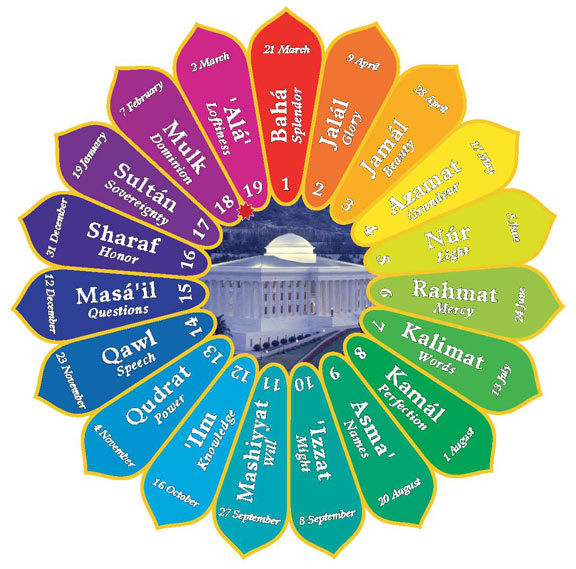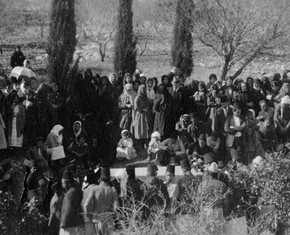The views expressed in our content reflect individual perspectives and do not represent the authoritative views of the Baha'i Faith.
As every calendar does, the Baha’i calendar charts physical time – but it also inspires spiritual progress by associating time with the cultivation of human nobility.
The precise name for the Baha’i calendar is the Badı` (“Unique” or “Wondrous”) calendar. It originated with the Bab (“the Gate”), who founded the Babi religion, soon superseded by the Baha’i Faith, established by Baha’u’llah in 1863. Adopting and modifying the Badi` calendar for use by the Baha’i community, Baha’u’llah invested time itself with spiritual significance. He transformed time by the naming of weekdays, days of the month, months, years, and cycles of years after spiritual perfections that can be translated into goodly virtues, such as “Beauty” (Jamal) “Knowledge” (‘Ilm), “Honor” (Sharaf), and “Grandeur” (‘Azamat), which are names of 4 of the 19 Baha’i months.

Artwork by Randall Dighton
These dynamic “names of God” each highlight a distinctive quality of sterling character and human nobility, in a process of transformation that we could call theophoric metamorphosis. Literally, the term “theophoric,” as its Greek root indicates, means “God-bearing.” Here, the “names” of God may be conceived of as “qualities” or, better still, as “powers” of God that we can potentially develop. In the Bab’s Kitab al-Asma’ (“Book of [Divine] Names”), which exceeds 3,000 pages and is said to be “the largest revealed book in sacred history,” the Bab treats human beings as reflections of divine names and attributes. To the extent that a person is a “bearer” of one of the “names” (i.e., qualities or powers) of God, that individual is empowered to express that quality in human action. Through the progressive spiritualization of all persons, the Bab wished to transform all of reality into “mirrors” reflecting the perfections represented by these divine names.
Of course, the mere fact that the name of a given Baha’i month suggests a spiritual quality that can be acquired as a human virtue does not, alone, accomplish that result. No burst of insight will emanate from the simple recitation of, say, “Grandeur.” Meditating on a virtue and then manifesting it is part and parcel of Baha’i self-transformation.
Take, for example, the quality of generosity. In The Hidden Words, Baha’u’llah states that giving to the poor is a human expression of divine generosity:
O CHILDREN OF DUST! Tell the rich of the midnight sighing of the poor, lest heedlessness lead them into the path of destruction, and deprive them of the Tree of Wealth. To give and to be generous are attributes of Mine; well is it with him that adorneth himself with My virtues. – The Hidden Words, p. 39.
The idea that the divine names have a transformative potential can be seen in this passage from the Persian Bayan 5:4:
For the divine Cycle advanceth in stages, until such Revelation when all things will be called by the names of God, such that no name will be assigned to anything unless it resembleth one of the names of God, glorified and exalted is He. . . . This will occur gradually and in stages, until all heaven, earth, and that which lieth between them, will be filled with the names of God. . . . Well is it with the people of that age who call nothing but by a name of God. That age is worthy to be praised as the beginning of the worlds of paradise! – Provisional translation by Saiedi, Gate of the Heart, p. 334.
These “stages” of transformation involve a process. Beyond the contemplative life, so classically modeled by monks and mendicants in cloistered isolation, the various names of God must be effectively translated from the realm of ideals into the arena of social action, in order for a truly spiritual transformation to take place.
For example: by contemplating and “translating” the word “Light” (the name of the fifth Baha’i month) into a personal virtue for the social commonweal, you could conceive of a way to enlighten others. By meditating on the name, “Knowledge” (the name of the 12th Baha’i month) and then manifesting that attribute in action, we can decide to impart beneficial insight or information to others. In the same vein, by reflecting deeply, then acting on the divine name, “Mercy” (the name of the sixth Baha’i month), you elect to perform a singular deed of mercy or kindness by ministering to the sick, poor, or otherwise disadvantaged members of society. Here, a godly “name” is effectively expressed as a goodly action. The Baha’i calendar not only charts the march of time, but addresses the quality of time by synergistically inspiring the progress of soul and society.
By charting physical time and associating time with divine perfections translatable as human virtues, the Baha’i calendar not only quantitatively measures a given point in time, but qualitatively measures the progress of the soul in relation to the social moment. Thus, the theophoric (“God bearing”) nature of the calendar, in theory, becomes theomorphic (“God manifesting”) in practice — whereby the Baha’i calendar may prospectively live up to its name, Badi‘ (“Wondrous”).
So, today, why not try turning a mundane minute into a golden moment by transforming a godly “name” into a goodly action?
Further reading: The Badí Calendar
Christopher Buck and J. Gordon Melton, “Baha’i Calendar and Rhythms of Worship.” Religious Celebrations: An Encyclopedia of Holidays, Festivals, Solemn Observances, and Spiritual Commemorations. By J. Gordon Melton, with James A. Beverley, Christopher Buck, and Constance A. Jones. Santa Barbara, CA: ABC-CLIO, 2011. Vol. 1, pp. 79–86.
















Comments
Sign in or create an account
Continue with Googleor